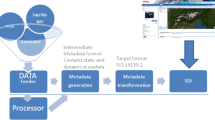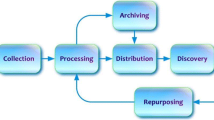Abstract
Recent advances in Semantic Web and Web Service technologies has shown promise for automatically deriving geospatial information and knowledge from Earth science data distributed over the Web. In a service-oriented environment, the data, information, and knowledge are often consumed or produced by complex, distributed geoscientific workflows or service chains. In order for the chaining results to be consumable, sufficient metadata for data products to be delivered by service chains must be provided. This paper proposes automatic generation of geospatial metadata for Earth science virtual data products. A virtual data product is represented using process models, and can be materialized on demand by dynamically binding and chaining archived data and services, as opposed to requiring that Earth science data products be physically archived. Semantics-enabled geospatial metadata is generated, validated, and propagated during the materialization of a virtual data product. The generated metadata not only provides a context in which end-users can interpret data products before intensive execution of service chains, but also assures semantic consistency of the service chains.










Similar content being viewed by others
Notes
Land cover classes defined by the International Geosphere-Biosphere Programme (IGBP)
An example OWL-S file for the wildfire prediction service is available at http://www.laits.gmu.edu/geo/ontology/owls/ap/v1/wps_wildfireprediction.owl.
This case was demonstrated in the Semantic Web Challenge of the 5th International Semantic Web conference in Athens, GA, USA. The final service chain represented using OWL-S is available at http://www.laits.gmu.edu/geo/nga/demo2/cp.owl.
This case was successfully demonstrated in July 2007 at Summer ESIP Federation meeting in University of Wisconsin, Madison, Wisconsin, USA. The final service chain represented using OWL-S is available at http://www.laits.gmu.edu/geo/ontology/owls/cp/wildfirecase.owl.
References
Foster I (2005) Service-oriented science. Science 308(5723):814–817
Yang C, Raskin R, Goodchild M, Gahegan M (2010) Geospatial cyberinfrastructure: past, present and future. Comput Environ Urban Syst 34(4):264–277
Brodaric B, Fox P, McGuinness DL (2007) Geoscience knowledge representation in cyberinfrastructure. Comput Geosci 35(4):697–868
Berners-Lee T, Hendler J, Lassila O (2001) The semantic web. Sci Am 284(5):34–43
Yue P, Gong J, Di L, He L, Wei Y (2009) Integrating semantic web technologies and geospatial catalog services for geospatial information discovery and processing in cyberinfrastructure. GeoInformatica. doi:10.1007/s10707-009-0096-1
Greenberg J, Spurgin K, Crystal A (2006) Functionalities for automatic metadata generation applications: a survey of metadata experts’ opinions. Int J Metadata Seman Ontologies 1(1):3–20
Albassuny BM (2008) Automatic metadata generation applications: a survey study. Int J Metadata Seman Ontologies 3(4):260–282
Lemmens R, Wytzisk A, Rd B, Granell C, Gould M, van Oosterom P (2006) Integrating semantic and syntactic descriptions to chain geographic services. IEEE Internet Comput 10(5):18–28
Lutz M (2007) Ontology-based descriptions for semantic discovery and composition of geoprocessing services. GeoInformatica 11(1):1–36
Percivall G (ed) (2002) The OpenGIS abstract specification, topic 12: OpenGIS service architecture, Version 4.3, OGC 02-112. Open Geospatial Consortium, Inc., 78pp
Rao J, Su X (2004) A survey of automated web service composition methods. In: Proceedings of the First International Workshop on Semantic Web Services and Web Process Composition (SWSWPC 2004). San Diego, CA, USA, pp 43–54
Srivastava B, Koehler J (2003) Web service composition—current solutions and open problems. In: Proceedings of ICAPS 2003 Workshop on Planning for Web Services. Trento, Italy, pp 28–35
Peer J (2005) Web service composition as AI planning—a survey. Technical Report, University of St.Gallen, Switzerland, 63pp
Evans J (2003) Web Coverage Service (WCS), Version 1.0.0, OGC 03-065r6. Open Geospatial Consortium, Inc., 67pp
ISO/TC 211 (2003) ISO19115:2003, Geographic Information—Metadata
Nebert D, Whiteside A, Vretanos P (eds) (2007) OpenGIS® Catalog Services Specification, Version 2.0.2, OGC 07-006r1. Open GIS Consortium Inc. 218 pp
Gruber TR (1993) A translation approach to portable ontology specification. Knowl Acquis 5(2):199–220
Baader F, Nutt W (2003) Basic description logics. In: Baader F, Calvanese D, McGuinness D, Nardi D, Patel-Schneider P (eds) The description logic handbook. Theory, implementation and applications. Cambridge University Press, Cambridge, pp 47–100
Kolas D, Hebeler J, Dean M (2005) Geospatial semantic web: architecture of ontologies. In: Proceedings of the First International Conference on GeoSpatial Semantics (GeoS 2005). Mexico City, Mexico, pp 183–194
Dean M, Schreiber G (eds) (2004) OWL Web ontology language reference. World Wide Web Consortium (W3C). http://www.w3.org/TR/owl-ref. Accessed 19 November 2009
Klyne G, Carroll JJ (eds) (2004) Resource Description Framework (RDF): concepts and abstract syntax. World Wide Web Consortium (W3C), http://www.w3.org/TR/2004/REC-rdf-concepts-20040210/. Accessed 19 November 2009
Yue P, Di L, Yang W, Yu G, Zhao P (2007) Semantics-based automatic composition of geospatial web services chains. Comput Geosci 33(5):649–665
Martin D, Burstein M, Hobbs J, Lassila O, McDermott D, McIlraith S, Narayanan S, Paolucci M, Parsia B, Payne T, Sirin E, Srinivasan N, Sycara K (2004) OWL-based web service ontology (OWL-S). http://www.daml.org/services/owl-s/1.1/overview/. Accessed 26 November 2009
Christensen E, Curbera F, Meredith G, Weerawarana S (2001) Web Services Description Language (WSDL) 1.1. World Wide Web Consortium (W3C), http://www.w3.org/TR/wsdl. Accessed 23 June 2006
Cardoso J, Sheth A (2005) Introduction to semantic web services and web process composition. In: Cardoso J, Sheth A (eds) Proceedings of the First International Workshop on Semantic Web Services and Web Process Composition (SWSWPC 2004). Lecture notes in computer science, vol 3387. Springer, Berlin, p 14
Clark J (1999) XSL Transformations (XSLT). World Wide Web Consortium (W3C), http://www.w3.org/TR/xslt. Accessed 6 August 2006
Bishr Y (1998) Overcoming the semantic and other barriers to GIS interoperability. Int J Geogr Inf Sci 12(4):299–314
Sheth A (1999) Changing focus on interoperability in information systems: from system, syntax, structure to semantics. In: Goodchild MF, Egenhofer M, Fegeas R, Kottman CA (eds) The Interoperating Geographic Information Systems. Kluwer, New York, pp 5–30
Kuhn W (2005) Geospatial semantics: why, of what, and how? J Data Seman III LNCS 3534:1–24
Batcheller J (2008) Automating geospatial metadata generation—an integrated data management and documentation al approach. Comput Geosci 34(4):387–398
Mohammadi H, Rajabifard A, Williamson IP (2010) Development of an interoperable tool to facilitate spatial data integration in the context of SDI. Int J Geogr Inf Sci 24(4):487–505
Friis-Christensen A, Ostlander N, Lutz M, Bernard L (2007) Designing service architectures for distributed geoprocessing: challenges and future directions. Trans GIS 11(6):799–818
Foster I, Kesselman C, Tuecke S (2001) The anatomy of the grid: enabling scalable virtual organizations. Int J Supercomput Appl 15(3):200–222
Gahegan M, Luo J, Weaver SD, Pike W, Banchuen T (2009) Connecting GEON: making sense of the myriad resources, researchers and concepts that comprise a geoscience cyberinfrastructure. Comput Geosci 35(4):836–854
Vaquero LM, Rodero-Merino L, Caceres J, Lindner M (2009) A break in the clouds: towards a cloud definition. ACM SIGCOMM Comput Commun Rev 39(1):50–55
De Longueville B (2010) Community-based geoportals: the next generation? Concepts and methods for the geospatial Web 2.0. Comput Environ Urban Syst 34(4):299–308
Ponnekanti SR, Fox A (2002) SWORD: a developer toolkit for web service composition. In: Proceedings of the International World Wide Web Conference. Honolulu, Hawaii, USA, May 2002, pp 83–107
Sirin E, Parsia B, Wu D, Hendler J, Nau D (2004) HTN planning for web service composition using SHOP2. J Web Semant 1(4):377–396
Klusch M, Gerber A, Schmidt M (2005) Semantic web service composition planning with OWLS-Xplan. In: Proceedings of the Agents and the Semantic Web, 2005 AAAI Fall Symposium Series. Arlington,Virginia, USA, November, 2005, 8 pp
Zaharia R, Vasiliu L, Hoffman J, Klien E (2009) Semantic execution meets geospatial web services: a pilot application. Trans GIS 12(s1):59–73
Foster I, Vockler J, Wilde M, Zhao Y (2002) Chimera: A virtual data system for representing, querying, and automating data derivation. In: Kennedy J (ed) Proceedings of the 14th International Conference on Scientific and Statistical Database Management (SSDBM’02). Edinburgh, Scotland, IEEE Computer Society, pp 37–46
Di L (2004) GeoBrain-a web services based geospatial knowledge building system. In: Proceedings of NASA Earth Science Technology Conference 2004. June 22–24, 2004. Palo Alto, CA, USA, 8 pp
Zhao J, Goble C, Greenwood M, Wroe C, Stevens R (2003) Annotating, linking and browsing provenance logs for e-Science. In: Proceedings Workshop on Semantic Web Technologies for Searching and Retrieving Scientific Data, Sanibel Island, Florida, USA, 6 pp
Kim J, Gil Y, Ratnakar V (2006) Semantic metadata generation for large scientific workflows. In: Proceedings of the 5th International Semantic Web Conference. Athens, Georgia, USA, Lecture notes in computer science, vol 4273. Springer, Berlin, pp 357–370
Yue P, Gong J, Di L (2010) Augmenting geospatial data provenance through metadata tracking in geospatial service chaining. Comput Geosci 36(3):270–281
SWSI (2004) Semantic Web Services Initiative (SWSI). http://www.swsi.org/. Accessed 21 March 2008
Drexel (2004) ISO 19115 metadata ontology. Drexel University, USA, http://loki.cae.drexel.edu/~wbs/ontology/. Accessed 17 October 2005
Horrocks I, Patel-Schneider PF, Boley H, Tabet S, Grosof B, Dean M (2004) SWRL: a semantic web rule language combining OWL and RuleML. W3C Member Submission, http://www.w3.org/Submission/SWRL/. Accessed 12 March 2007
Prud’hommeaux E, Seaborne A (eds) (2006) SPARQL query language for RDF. World Wide Web Consortium (W3C), http://www.w3.org/TR/rdf-sparql-query/. Accessed 21 November 2009
OWL-S API (2004) OWL-S API. Maryland Information and Network Dynamics Lab Semantic Web Agents Project (MINDSWAP), http://www.mindswap.org/2004/owl-s/api/. Accessed 19 November 2009
Jena (2006) Jena. Hewlett-Packard Labs Semantic Web Programme, http://jena.sourceforge.net. Accessed 19 November 2009
Yue P, Di L, Yang W, Yu G, Zhao P, Gong J (2007) Semantics-enabled metadata generation, tracking and validation in the geospatial web service composition for distributed image mining. In: Proceedings 2007 IEEE International Geoscience and Remote Sensing Symposium (IGARSS07). 23 July–27 July 2007, Barcelona, Spain, pp 334–337
52n WPS (2006) 52n Web Processing Service (WPS). https://www.incubator52n.de/twiki/bin/view/Processing/52nWebProcessingService. Accessed 16 October, 2006
Yue P, Gong J, Di L, Yuan J, Sun L, Wang Q (2009) GeoPW: towards the geospatial processing web. In: Proceedings of the 9th International Symposium on Web and Wireless Geographical Information Systems (W2GIS 2009). 7 & 8 December 2009, Maynooth, Ireland, Lecture notes in computer science, vol 5886. Springer, Berlin, pp 25–38
Kolas D (2008) Supporting spatial semantics with SPARQL. Trans GIS 12(s1):5–18
Golden K (2003) A domain description language for data processing. In: Proceedings of the International Conference on Automated Planning and Scheduling, Workshop on the Future of PDDL. Trento, Italy, June 9–13, 2003, 10pp
Chien S, Fisher F, Lo E, Mortensen H, Greeley R (1999) Using artificial intelligence planning to automate science image data analysis. Intell Data Anal 3(3):159–176
Acknowledgments
We are grateful to the four anonymous reviewers, and to Dr. Barry Schlesinger for their detailed comments that helped improve the quality of the paper. This work was funded jointly by National Basic Research Program of China (2011CB707105), Project 40801153 and 41023001 supported by NSFC, LIESMARS and SKLSE (Wuhan University) Special Research Fundings.
Author information
Authors and Affiliations
Corresponding author
Rights and permissions
About this article
Cite this article
Yue, P., Gong, J., Di, L. et al. Automatic geospatial metadata generation for earth science virtual data products. Geoinformatica 16, 1–29 (2012). https://doi.org/10.1007/s10707-011-0123-x
Received:
Revised:
Accepted:
Published:
Issue Date:
DOI: https://doi.org/10.1007/s10707-011-0123-x




